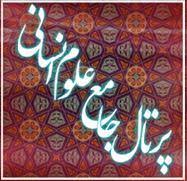About the journal
This journal is following of Committee on Publication Ethics (COPE) and complies with the highest ethical standards in accordance with ethical laws”.
Recent Articles
-
Open Access Article
1 - Abu Nasr Sarraj Tousi’s Innovation in the Issue of Mystical States in Al-Luma’
marzieh peyvandi ، قدرت ا... خیاطیان * ، mohamadjavad danialiIssue 82 , Vol. 21 , Winter 2025 -
Open Access Article
2 - Mystical Analysis of the Manifestation of Beauty and Love from the Perspective of Ayn al-Quzat and Ruzbihan Baqli
sepideh khoshsaligheh ، heidar gholizadeh *Issue 82 , Vol. 21 , Winter 2025 -
Open Access Article
3 - The Truth of the Universe and its Role in Divine Grace and a Comparison with Levels of the Merciful Soul Based on Islamic and Mystical Interpretations
Mahdi imanimoghaddam * ، رضا جمالیIssue 82 , Vol. 21 , Winter 2025 -
Open Access Article
4 - The interaction of religion and mysticism in the interpretations of the Qur'an (Case study: interpretations of Basayer Yamini)
sedighe solimani * ، yosef Aali abbas AabadIssue 82 , Vol. 21 , Winter 2025 -
Open Access Article
5 - History of the Souls: The Meaning world of Some Iranian Paintings about Kay Khosrow Based on Corbin’s Conception of Symbolic History in His Phenomenological-Hermeneutical Approach
monireh panjtani * ، shahriar shokrpourIssue 82 , Vol. 21 , Winter 2025 -
Open Access Article
6 - Seyyed Heydar Amoli's View on Ethics in Mystical Journey
nasrin tavakoli * ، babak zarrat nooriIssue 82 , Vol. 21 , Winter 2025 -
Open Access Article
7 - Revival of Qadiriyya in the Qajarid Kurdistan and the Relation of Barzanji(The Sule’i) Sheykhs with the Ghajarid Court and Their Social Place in the Region
vali allah saki *Issue 82 , Vol. 21 , Winter 2025 -
Open Access Article
8 - The Streaks of Mysticism in Azhari Shirazi Diwan
rana noohi ، Ali Asghar Dadbeh * ، abdolreza modarreszadehIssue 82 , Vol. 21 , Winter 2025 -
Open Access Article
9 - Analysis of the Components of Mowlavi’s Verbal and Spiritual Intelligence in Masnavi Ma'navi Based on Howard Gardner's Theory
zohreh hoseini ، Abolghasem Amirahmadi * ، ali karimiIssue 82 , Vol. 21 , Winter 2025 -
Open Access Article
10 - Disasters in Bahāʾ Valad’s Life and Analisys of the Main Components of His Mystical Belief
jamshid jalali sheyjani, *Issue 82 , Vol. 21 , Winter 2025 -
Open Access Article
11 - Annihilation (Fana) of Attributes in Islamic Mysticism based on Transcendent Theosophy
سید حاتم مهدوی نور * ، mahmood ghayyoomzadehIssue 82 , Vol. 21 , Winter 2025 -
Open Access Article
12 - Manifestation of Plotin's Philosophical-Mystical Teachings in Attar Nishaburi's Theology
soheila zeynali ، hosein arian * ، nozhat noohiIssue 82 , Vol. 21 , Winter 2025 -
Open Access Article
13 - Manifestation of the Aesthetics of Islamic Mysticism in the Framework and the Meaning
mahboobeh zamani ، amir akbari *Issue 82 , Vol. 21 , Winter 2025 -
Open Access Article
14 - Investigation of Some Mithraic Symbols in Islamic Mysticism
maryam shabani ، Alisoroor yaghoobi * ، mohsen izadyarIssue 82 , Vol. 21 , Winter 2025 -
Open Access Article
15 - Analyzing death and death thoughts in Sufi prose (with an emphasis on prose texts from the 6th to 10th centuries of Hijri)
sara shahsavar ، farhad edrisi *Issue 82 , Vol. 21 , Winter 2025 -
Open Access Article
16 - Mystical Analysis of the Concept of “Alast” in Attar's Poems
leyla moosavi ، سیاوش مرادی *Issue 82 , Vol. 21 , Winter 2025 -
Open Access Article
17 - A Comparative Analysis of the Concept of Love and Peace in Mawlana’s and Rosenberg's works
maryam babayi ، reza heydari * ، mohammadtaghi ghandiIssue 82 , Vol. 21 , Winter 2025 -
Open Access Article
18 - Ayn al-Quzat’s Practical Mysticism and the Originalty of the Religions
mohammad heydarnezhad ، Alieyn Alilou * ، شهین اوجاق علیزادهIssue 82 , Vol. 21 , Winter 2025 -
Open Access Article
19 - Investigating the Positive Ideas of Humanity and Transcendence in Rumi's Divan-e Shams and the Divan of Hafez
esmail eslami ، خیرالنّساء محمّدپور *Issue 82 , Vol. 21 , Winter 2025 -
Open Access Article
20 - The Impact of Islamic Mysticism on the Paradoxes of Mawlana’ and Hafez’s Lyric Poems
sara ghati ، Maryam Zibaeenejad * ، morteza jafariIssue 82 , Vol. 21 , Winter 2025 -
Open Access Article
21 -
Issue 82 , Vol. 21 , Winter 2025
Most Viewed Articles
-
Open Access Article
1 - The Role of Phantom in Religious Training, Regarding to the Islamic Mysticism and Wisdom
MohammadTaghi Yousefi ، Yarali Kord Firoozjayi ، saeed ahmadi *Issue 72 , Vol. 19 , Summer 2022 -
Open Access Article
2 - Understanding the Allegory of Ayat al- Nur from the Perspective of Mystical Interpretations
Reza Bahri ، Seyyed Ahmed Miriyan Akandi * ، Mohammad Hadi YadollahpurIssue 78 , Vol. 20 , Winter 2023 -
Open Access Article
3 - Manifestation of Mystic Themes in Vahshi e-Bafghi’s Khold e-Barin
Seyedeh Zahra Alavi ، Sharare elhami * ، Badrieh Ghavami ، Reza BorzueiIssue 76 , Vol. 20 , Summer 2023 -
Open Access Article
4 - Heart in Islamic Mysticism
Seyyed Nader MohammadzadehIssue 38 , Vol. 10 , Winter 2015 -
Open Access Article
5 - Hafiz Rajab Borsi’s Point of View about the Perfect Human from the Perspective of Islamic Mysticism
Hossein Tahmasb Kazemi, Hasan Saeidi ، hasan saeidi *Issue 78 , Vol. 20 , Winter 2023 -
Open Access Article
6 - Exploring the Stages of Gaining Anti-habit in Ibn al-Farez’s Mystical Poems
Shahla Noruzy Raad ، Naser Hoseini * ، Ardeshir SadreddiniIssue 78 , Vol. 20 , Winter 2023 -
Open Access Article
7 - The Analysis of Sheikh Gilāni's Mystical Discourse Based on Conceptual Metaphor of Love in His Lyrics
Arezu Ghaderi ، Akram Korani * ، Masud DehghanIssue 78 , Vol. 20 , Winter 2023 -
Open Access Article
8 - A Study of Mystical Concepts in Emlaye Bukharaei’s Divan
Tahereh Safavinezhad ، Jalil Nazari * ، Mohammadreza MasumiIssue 78 , Vol. 20 , Winter 2023 -
Open Access Article
9 - The Function of Mystical Urgency in Mental Growth and Excellence
yadollah nasrollahy * ، Rahim Yusefi ، Jafar GheibiIssue 78 , Vol. 20 , Winter 2023 -
Open Access Article
10 - Hurufism in Ottoman Empire: Case Study
Masoumeh Dorsar ، mahbub mahdaviyan * ، Alireza RoohimirabadiIssue 66 , Vol. 17 , Winter 2020














